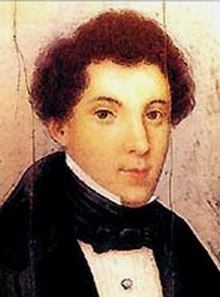Juan Crisóstomo de Arriaga

Juan Crisóstomo de Arriaga y Balzola (born Bilbao 27 January 1806; died Paris 17 January 1826) was an early 19th-century Spanish composer. He was still only 19 years old when he died. Like Mozart, he was a child prodigy and he might have become one of the world’s most famous composers if he had lived.
His life[change | change source]
Juan Crisóstomo Arriaga was born in Bilbao, in the Basque Country in Spain. His father and older brother first taught him music. He started to compose when he was 11 years old, and by the time he was 15 he had already written 20 works. Many of these are now lost. He may have thrown them away, thinking that they were not very good. In 1921 he went to Paris where he studied the violin with Pierre Baillot, and counterpoint and harmony with François-Joseph Fétis at the Paris Conservatoire. He was so good that by 1824 he had become a teaching assistant in Fétis's class.
Arriaga died in Paris at the age of nineteen, probably of a lung disease and exhaustion.
His music[change | change source]
Arriaga has been called “The Spanish Mozart”. His music, however, does not sound particularly Spanish. It has a more general European character, based on the style of Mozart and Beethoven. He wrote a symphony which sounds at times like Schubert. He also wrote an opera Los esclavos felices ("The Happy Slaves"), and three string quartets. The string quartets were the only works that were published while he was still alive.
